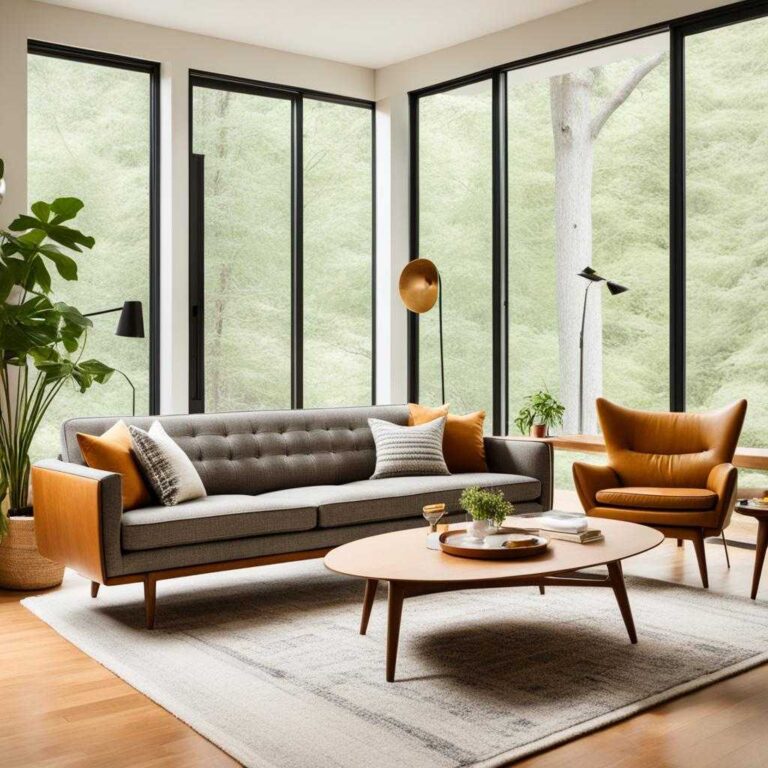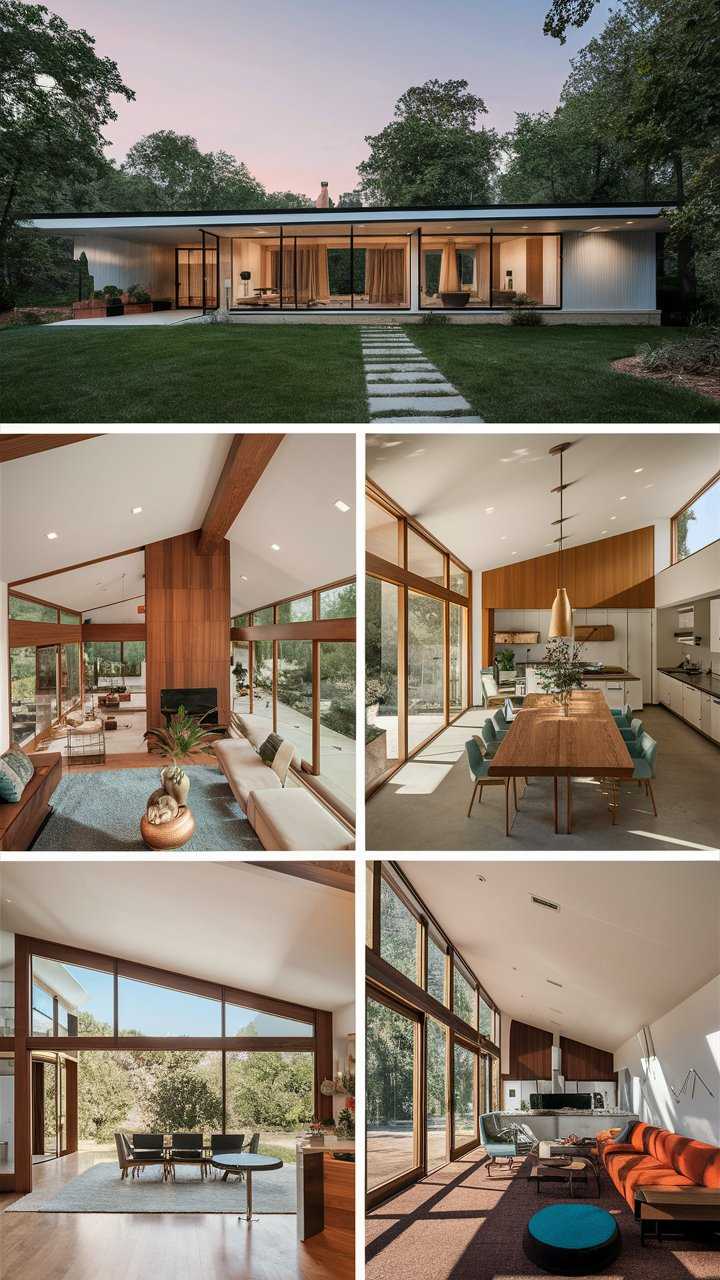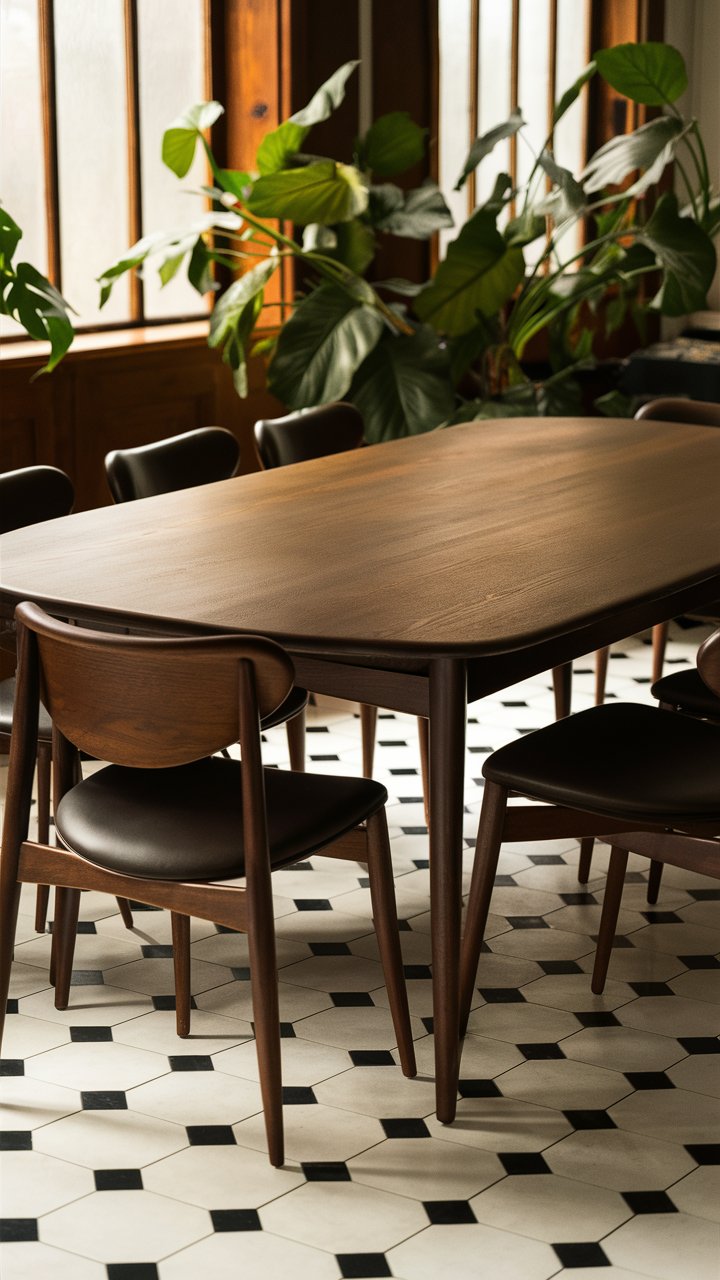Discover the Charm of Mid Century Modern Houses
Mid-century modern houses are known for their timeless look. They have clean lines, soft curves, and mix function with style perfectly. This style became popular after World War II and has won over many people’s hearts.
It ranges from the classic ranch-style homes in Southern California to the sleek, simple houses in the Midwest. Mid-century modern homes bring the outdoors inside. They make a smooth transition between indoor and outdoor living. This lets people enjoy nature right in their homes.
Key Takeaways
- Mid-Century Modern design is defined by clean lines, organic curves, and a focus on functionality.
- This style emerged in the post-World War II era and embraced the integration of indoor and outdoor living spaces.
- Mid-Century Modern homes often feature open floor plans, large windows, and a harmonious relationship with the surrounding landscape.
- While some homeowners opt for a full mid-century modern aesthetic, incorporating elements of this iconic style can easily elevate any contemporary living space.
- Mid-Century Modern design celebrates the use of natural materials, bold colors, and a minimalist approach to decor.
Explore the Origins of Mid-Century Modern Architecture
Mid-century modern architecture, known as “MCM,” thrived from the mid-1930s to the late 1960s. This style was influenced by the cultural and technological changes after World War II. The post-war era brought hope and a wish for new starts, causing a housing boom and design innovation.
Post-War Optimism and Innovation
World War II’s end brought a fresh energy and a feeling of possibility. Architects and designers wanted to try new materials and ideas. This led to open floor plans, indoor-outdoor connections, and a focus on natural light and air.
Mid-century modern architecture aimed to make spaces that looked good and worked well.
Influences from the International Style and Bauhaus Movement
Mid-century modern architecture was shaped by the International Style and the Bauhaus movement. These styles valued simplicity, function, and avoiding too much decoration. The clean lines and simple shapes of mid-century homes came from these influences.
Integration with Nature
Mid-century modern homes were designed to connect indoors and outdoors. Large windows, sliding doors, and open layouts brought nature inside. This made homes feel in tune with the environment. Using natural materials like wood and stone also helped link the home to nature.
“Mid-century modern architecture was a reflection of the cultural zeitgeist, a response to the changing social and technological landscape of the post-war era.”
Iconic Mid-Century Modern Architects
The mid-century modern movement changed the way we see buildings. Architects like Frank Lloyd Wright, Ludwig Mies van der Rohe, and Richard Neutra made big impacts. They each brought their own style to the era.
Frank Lloyd Wright’s Organic Architecture
Frank Lloyd Wright led the organic architecture movement. He made buildings blend with nature. His famous Fallingwater in Pennsylvania is a perfect example.
Wright used natural materials and open designs. He connected indoor and outdoor spaces. These ideas became key to mid-century modern style.
Ludwig Mies van der Rohe’s Minimalism
Ludwig Mies van der Rohe was a big name in the International Style. He believed in “less is more.” His buildings had clean lines and simple beauty.
His Farnsworth House and Seagram Building show his love for minimalism. This style became a symbol of mid-century modern design.
Richard Neutra’s Southern California Designs
In Southern California, Richard Neutra designed homes that felt like they were part of the landscape. His Kaufmann Desert House had big windows and blended with the outdoors.
Neutra’s work showed how mid-century modern design could connect with nature. It brought sophistication and a love for the outdoors into homes.
“The ultimate goal of architecture, like that of all the plastic arts, is to organize the infinite variety of phenomena of the visible world into a clear image of intellectual and emotional significance.”
– Richard Neutra
| Architect | Architectural Style | Key Works |
|---|---|---|
| Frank Lloyd Wright | Organic Architecture | Fallingwater, Robie House |
| Ludwig Mies van der Rohe | Minimalism, International Style | Farnsworth House, Seagram Building |
| Richard Neutra | Southern California Modernism | Kaufmann Desert House, Lovell Health House |
Defining Characteristics of Mid Century Modern Houses
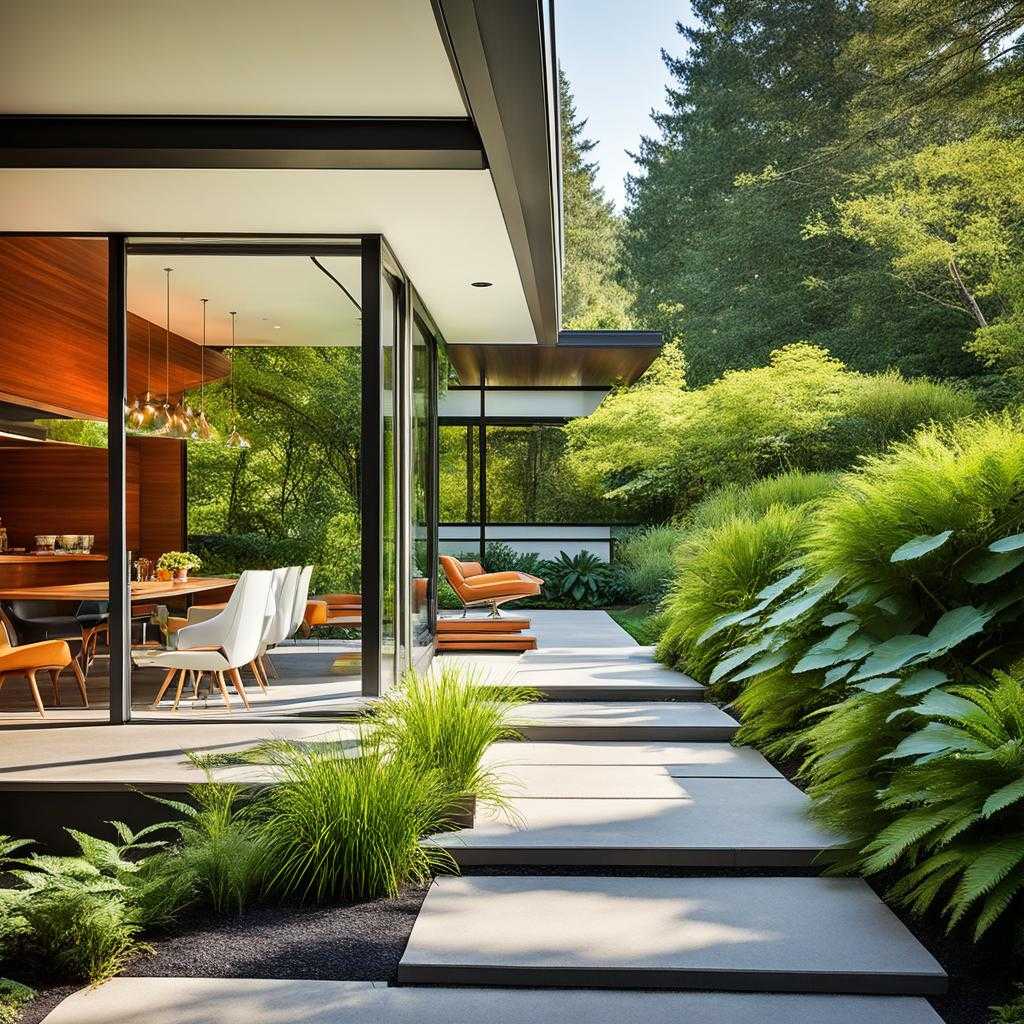
The mid-century modern style is known for its clean lines and simple look. These homes avoid fancy decorations for a simple, useful design. They let the beauty of the building shine through. Clean lines and simplicity are key, giving a sophisticated look without being too fancy.
Clean Lines and Minimalist Aesthetic
Mid-century modern houses love simplicity and focus on clean lines and a simple look. They use little decoration, letting the building’s shape be the main attraction. The outside has smooth surfaces, sharp edges, and few details. Inside, you’ll find open spaces and a mix of natural materials.
Open Floor Plans
Open floor plans are a big part of mid-century modern design. Walls are often taken down or not used at all. This makes the living areas flow together, making the home feel bigger and brighter. It also connects different parts of the house more closely.
Blending Indoor and Outdoor Living Spaces
Mid-century modern homes are great at mixing indoor and outdoor living. Big windows, sliding doors, and skylights let nature inside, linking the house to the outdoors. This design encourages a lifestyle that values the beauty of nature.
| Characteristic | Description |
|---|---|
| Clean Lines and Minimalist Aesthetic | Prioritize simplicity and restraint, with a focus on clean lines and a minimalist approach to design. |
| Open Floor Plans | Feature open, airy layouts with minimized walls, promoting a sense of spaciousness and natural light. |
| Blending Indoor and Outdoor Living | Utilize large windows, sliding glass doors, and skylights to seamlessly integrate the indoor and outdoor spaces. |
“The great living room should flow, not only within itself, but connect with the outside.” – Frank Lloyd Wright
Mid-century modern houses are known for their timeless beauty and practicality. They have clean lines, a simple look, open spaces, and blend indoor and outdoor living well. This approach to design has made the mid-century modern style a favorite among architects and homeowners alike.
mid century modern house: The Epitome of Modern Living

The mid-century modern house is a symbol of simplicity and functionality. It shows how to live well with nature. This style came after World War II and showed a new hope and creativity.
Designers of this time loved nature. They made homes that feel like they’re part of the outdoors. Big windows, open spaces, and materials like wood and stone helped bring the outdoors in.
This house style changed how we live. It was all about making homes better for us. Clean designs and open spaces made life easier and more fun. It was a new way to live.
Today, the mid-century modern house is still popular. It’s known for its lasting design and flexibility. It shows how design can improve our lives.
“The mid-century modern house is not just a physical structure, but a manifestation of a lifestyle that embraces simplicity, functionality, and a deep connection with the natural world.”
Reinventing Modernism in Contemporary Mid-Century Homes
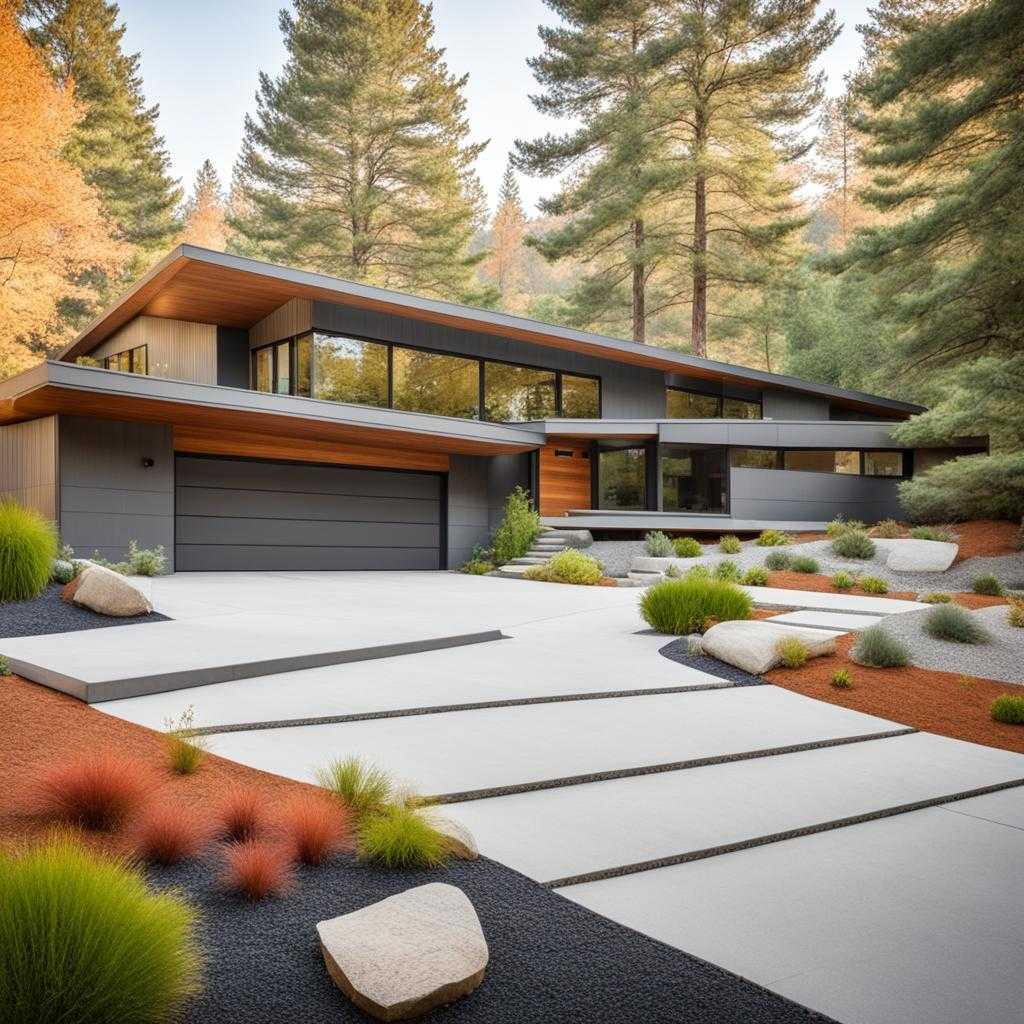
The charm of mid-century modern design is still winning hearts today. Now, we see new takes on this style that fit the 21st century. These contemporary mid-century homes mix sustainable materials and eco-friendly design with the classic look of mid-century modern. They keep the clean lines and the feel of indoor and outdoor living in harmony.
Sustainable Materials and Eco-Friendly Design
Today, making homes sustainable is a big goal in building. Modern mid-century homes are at the forefront of this movement. They use sustainable materials like reclaimed wood, solar panels, and energy-saving windows. This makes eco-friendly homes that look great and are good for the planet.
Cutting-Edge Design Meets Natural Desert Setting
In Palm Springs, California, the Desert Palisades show off this new take on mid-century modern. Here, modern architecture fits right into the desert landscape. It’s a beautiful mix of old and new design. This place shows how mid-century modern can be updated for today.
“These homes represent a new era of mid-century modern living, where sustainable design and environmental consciousness are as important as aesthetic appeal.”
Mid-century modern design is still loved by many. Now, it’s combined with sustainable materials and eco-friendly ways of building. These contemporary mid-century homes show a bright future for home design. They keep the best of modernism while meeting today’s needs.
Mid-Century Modern Furniture: Timeless Danish Craftsmanship

The mid-century modern style goes beyond just buildings and into furniture design. Danish craftsmanship shines here. Brands like Brdr. Krüger, started in 1886, make furniture that shows off clean lines and organic shapes. They focus on quality and detail, making each piece timeless.
These pieces are loved by those who value quality and design. They offer sleek chairs and elegant tables. Danish mid-century modern furniture has a timeless look that goes beyond trends.
What makes this furniture last is the focus on quality and detail. Danish design is all about mixing function and beauty. This makes the furniture both useful and beautiful.
“The essence of Danish design is found in the perfect balance between the functional and the beautiful.”
This mix of usefulness and beauty makes mid-century modern furniture a favorite. It looks great in mid-century homes or modern settings. These pieces keep their charm over time, thanks to Danish craftsmanship.
The Enduring Appeal of Danish Craftsmanship
Mid-century modern furniture’s lasting appeal comes from Danish design’s rich history and high quality. Brands like Brdr. Krüger focus on traditional methods and details. This has made mid-century modern furniture a symbol of timeless elegance.
- Emphasis on clean lines and organic forms
- Attention to material selection and craftsmanship
- Seamless integration of function and aesthetics
- Timeless appeal that transcends passing trends
These furniture pieces keep the spirit of Danish design alive while meeting modern needs. They have become the essence of mid-century modern style, loved by many over the years.
Celebrating Mid-Century Modern: From Frank Lloyd Wright to Contemporary Interpretations
The mid-century modern style still excites design lovers and changes how we live. It started with Frank Lloyd Wright’s iconic buildings and has grown to include modern desert designs in Palm Springs. This style has changed with the times, meeting new needs and tastes.
Today, designers take cues from mid-century modern’s clean lines and open spaces. They update these ideas for today’s lifestyles. This shows how mid-century design’s timeless values can be made new again.
Honoring the Past, Embracing the Future
Homeowners and designers love mid-century modern for its lasting charm. This style has evolved, using new materials and tech. It shows how mid-century modern homes stay relevant today.
The evolution of mid-century modern architecture shows its lasting impact. It mixes old and new, inspiring us with its innovative design. This style reminds us of the power of design to change our lives and environments.
“The principles of mid-century modern design are enduring because they are rooted in timeless values of functionality, simplicity, and harmony with nature.”
Mid-century modern continues to evolve, shaping our modern lives. Its influence on design is strong and inspiring. It affects how we live, work, and play today.
Conclusion: Embracing the Timeless Appeal of Mid-Century Modernism
The mid-century modern design still wins hearts today. It’s known for its simple beauty, practicality, and connection to nature. These qualities made it a key part of the post-World War II era.
Design legends like Frank Lloyd Wright and Ludwig Mies van der Rohe started it all. Now, we see new twists that mix old styles with today’s green tech and innovation. This shows how mid-century modernism stays fresh and important.
Restoring old mid-century homes or adding modern touches to new ones keeps this style alive. It shows how mid-century modern design still shapes our living spaces and our lives.
Mid-century modern homes are known for their sleek look, open spaces, and blending indoors with outdoors. They prove the lasting impact of this design movement on our lives.

